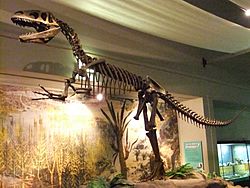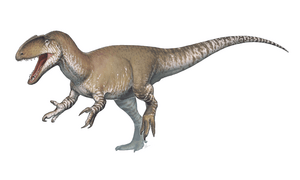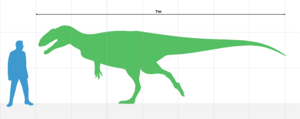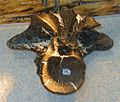Neovenator facts for kids
Quick facts for kids NeovenatorTemporal range: Lower Cretaceous, 125 mya
|
|
|---|---|
 |
|
| Restored skeleton | |
| Scientific classification | |
| Kingdom: | |
| Class: | |
| Superorder: | |
| Order: | |
| Suborder: | |
| Superfamily: | |
| Family: |
Carcharodontosauridae/
Neovenatoridae |
| Genus: |
Neovenator
|
Neovenator is a dinosaur related to the clade which contains Allosaurus as its key member. Since the discovery of Neovenator on the Isle of Wight, UK, it has become one of the best-known large carnivorous dinosaurs in Europe.
Neovenator was about 7.5 meters (24.5 feet) in length, and was of a slim build, weighting 1000–2000 kg. Some fossils suggest a length of about 10 meters (33 feet), but these fossils are very fragmentary. It lived during the early Cretaceous), about 125 million years ago.
Fossil remains of Neovenator have been found on the Isle of Wight (southern England), and were first discovered in the 20th century. Neovenator existed alongside Baryonyx, Polacanthus and Iguanadon in the early Cretaceous. It was one of the top predators of its day.
Description
Neovenator measured approximately 7.6 metres (25 ft) in length, and was of a gracile build, weighing 1,000 to 2,000 kilograms (2,200 to 4,400 lb). Specimen MIWG 4199 indicates an individual with a possible length of about 10 metres (33 ft), but it only consists of a toe phalanx and its position in Neovenator is dubious.
The various scientific descriptions of Neovenator have indicated some distinguishing traits.
The nostril is twice as long as it is high. The praemaxilla in the snout bears five teeth.
The rear neck vertebrae are fused with their neck ribs.
Several traits that once were thought to be unique or apomorphic for Neovenator, subsequent research showed to have been shared by other theropods. The nostrils are large but not uncommonly so. Having pneumatised rear back vertebrae is normal for carcharodontosaurids. Elevated paired nasal crests are shared with Allosaurus. Denticles continuing over the tooth apex are today known from other species.
In 2015, it was reported that the front of the snout of Neovenator contains a complex system of neurovascular canals, functioning as sensory organs. This trait is also known from Spinosauridae and was there explained as an adaptation for searching prey in water. It was doubted however, whether Neovenator used its system for the same purpose.
Images for kids
-
Mounted skeleton and fossils, Dinosaur Isle
-
Reconstructed skeleton, World Museum Liverpool








